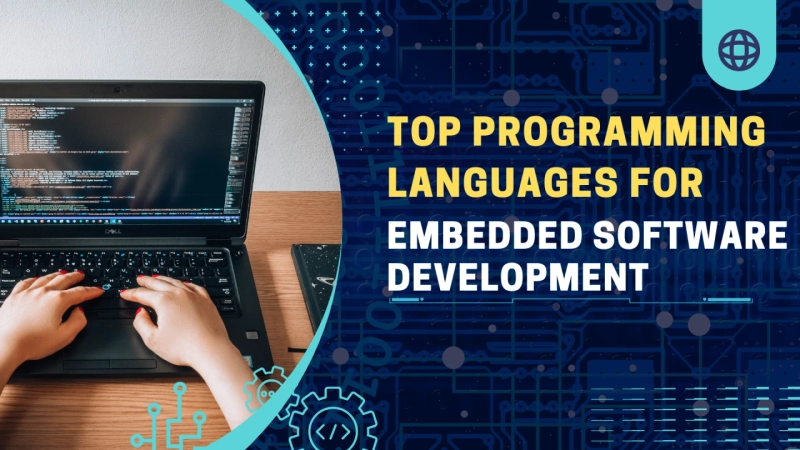Programming languages also hold immense importance in the context of embedded systems because they are used to create software that controls and monitors embedded hardware. Choosing a programming language speaks volumes about the prowess and scope of a project. As such, selecting a language for an embedded system involves understanding various factors, such as the hardware limits most embedded systems will face (e.g., memory limits, processing power, and software limits).
Let's start by discussing the most important programming languages for creating embedded systems:
The Most Essential Programming Languages For Embedded Systems
1. C++
Because of its effectiveness, performance, and adaptability, C++ is highly suited for systems with limited resources and is required for embedded technology and the Internet of Things. Project goals, limitations, and availability of necessary toolchains and libraries must all be assessed and taken into account. Hybrid techniques are beginning to be introduced in the future of embedded software development, where each language has its own distinct function and set of considerations and benefits.
Strengths
Some of the main advantages C++ has to offer while creating embedded systems are listed below:
- Small and flexible: C++ is relatively small compared to other higher-level programming languages and thus is ideal for embedded systems' memory constraint needs. Due to its nature as a low-level programming language, hardware interactions can be precisely controlled.
- Performance: C++ is highly efficient in performing critical operations in real time due to the fact that it provides direct hardware access, has effective memory handling, and optimizes data structures.
- Platform independence: C++ obviates the use of a complicated cross-platform deployment process and allows software developers to write code only once and then run it on multiple embedded system platforms, producing faster, better development cycles.
Considerations
Despite its advantages, C++ has certain drawbacks to take into account:
- Error-Prone: The manual memory management features included in C++ greatly raise the possibility of memory leaks and segmentation errors, which could result in system failures.
- Security problems: Because C++ uses a manual memory management procedure and permits direct hardware access, it exposes users to a number of security flaws, particularly if the software was not created with cyberattack defences in mind.
- Integration issues Despite C++'s many advantages, the embedded systems industry's ability to innovate is severely hampered by its difficulties with modernisation and integrating with new frameworks and technologies without the need for additional, complex libraries.
Applications
Here are some of the real-time applications of C++:
- Consumer electronics: Because C++ is perfect for maximising battery life and expediting the multimedia playing process, it is widely used in consumer electronics like gaming consoles, wearable technology, and smart TVs. As such, C++ is a useful tool to spur innovation in the sector.
- Automotive systems : C++ is ideally suited to the task of keeping pace with the requirements of real-time needs in the automotive industry, specifically for safety functions like anti-lock braking systems and airbags, where real-time responsiveness is a key factor.
2. Python
Recent studies show that Python is used as a programming language on about 1.4% of websites. Its broad ecosystem and ease of use make it an invaluable tool for specific applications and rapid development. To successfully include it into embedded systems projects, it is crucial to understand both its advantages and disadvantages.
Strengths
Here are a few of Python's main advantages:
- Extensive libraries - Extensive libraries are essential for bare metal frameworks like micropython and py-bricks, which guarantee direct hardware interface and precise control. Innovative embedded systems applications can be made using these specific implementations. Additionally, the Python Package Index provides a vast array of external components with pre-written code for applications like web development, machine learning, and data analysis.
- Cloud integration - Python's robust support for cloud connectivity makes it easy and safe to provision embedded systems with the cloud, allowing data to flow upstream without interruption. This enables complex tasks to be carried out on devices with limited resources, which is particularly beneficial for Internet of Things devices and other systems looking for seamless cloud integration.
Considerations
Despite Python's many benefits for developing embedded systems, there are a few things to keep in mind:
- Real-time processing - It is essential for employers to take into account the dedicated function of the embedded system. For real-time responsiveness, Python is not necessarily the best choice for systems with strict timing and response since Python's latency is not the most adequate for this.
- Memory management: Python uses Automatic Garbage Collection (GC), in which the interpreter releases memory that isn't being used by the program. Although this simplifies development, the possibility of latency spikes brought on by GC cycles makes it problematic for real-time embedded systems. This is especially important in systems where responsiveness is essential and erratic pauses are untrustworthy.
- Hardware access -When direct hardware and low-level resource control are needed in embedded systems, Python is usually not the ideal choice because it severely restricts debugging and interface with specific hardware components. This indicates that Python is less appropriate for writing code that must be responsive in real time and is more appropriate for writing performance-critical programming.
Applications
After going over the advantages and things to think about, let's look at some practical uses for Python:
- Online gaming: Python is integral to online gaming's functionality. For example, it is used for various tasks, such as server-side logic, scripting, and artificial intelligence. Moreover, Python offers a broad variety of frameworks and tools for developing online gaming backends and web frameworks.
- Video processing: Python's simplicity and wide range of capabilities make it suitable for electronic tasks such as frame-by-frame processing, real-time video editing, and the use of advanced image processing methodologies.
3. Java
One of the most prominent embedded systems programming languages is Java, which has singular strengths based on the functionality and particular requirements of the embedded system development process, especially those geared towards maintainability and security. Nevertheless, consideration of possible weaknesses should also be taken into account when assessing the needs of development.
Strengths
Java is regarded as one of the top programming languages for embedded systems because of the following advantages:
- Security: Java provides several security features, including sandboxing, to encourage security in resource-limited environments. For instance, sandboxing restricts applications from accessing system resources directly, minimizing possible attacks from malicious code.
- Object-oriented: Java's object-oriented attributes assist in coding and modularising code, which effectively supports maintainability and reusability. These attributes prove useful when developing sophisticated embedded systems.
- Cross-platform development -Java's cross-platform functionality provides several benefits for developing embedded systems, such as the fact that pre-coded code can be used, which can be shared across various systems with varying architectures, thus reducing a lot of time and money.
Considerations
Java is one of the most popular programming languages for embedded systems, although there are some significant disadvantages to using it:
- Performance: Java's interpretation and trash collection cause performance pauses, making it less performant than C++ when compared to other programming languages. For embedded systems that need precise timing, this is a major drawback.
- Memory: Because the Java Virtual Machine (JVM) requires memory and processing power to function, Java presents a risk to resource overhead. For embedded systems with limited resources, particularly memory and computing power, this could be a problem.
- Hardware compatibility: For embedded systems, especially those with low-level hardware characteristics, Java has poor hardware compatibility. Compatibility is further hampered by Java's memory overhead and speed.
Applications
Here are a few examples of Java's practical uses in embedded systems:
- Internet of Things (IoT) gateways: Java's extensive library and object-oriented nature make it an ideal programming language for creating gateways that collect data from IoT devices and build complex systems within them.
- Industrial automation: In order to control industrial devices, automation systems often utilize Java. Due to Java's object orientation and code reusability, it makes the development of embedded systems on different platforms easy.
Final Thoughts
The strength of each programming language emphasizes their significance for embedded system dome.) Because of very high competitiveness, efficiency, performance and platform independence, C++ is a widespread choice for resource-constrained systems in diverse application domains, including, but not limited to, consumer electronics, industrial automation or automotive systems. However, if we look into the reasons for its popularity over other language frameworks, users can quickly connect their database to laptops and PCs as all hardware connections can be implemented in Python, but this may restrict the use of few functionality options and lack of real-time processing.
It's important to take into account each programming language's unique constraints and concerns while comparing them. It's crucial to carefully consider these elements against project needs, as they may include memory management issues or potential security risks. The use of embedded systems programming languages in practical settings shows their adaptability in meeting the intricate requirements of development, despite these difficulties.



